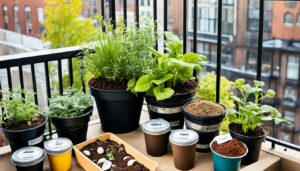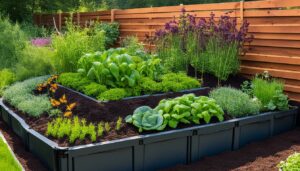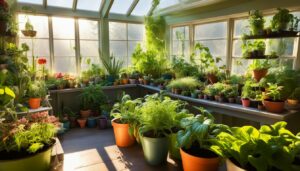Think back to a time when you were marveling at the seamless harmony of a forest – a rich, interwoven tapestry of flora and fauna, each species supporting and enhancing the life of another. This natural brilliance is what organic companion planting seeks to replicate within the borders of your own garden.
Within each seed and sapling lies not just the promise of growth, but an open invitation to be part of something bigger: a world where sustainable gardening practices redefine what it means to grow our food and nurture our environment. Imagine a garden where every plant is carefully chosen, not just for its yield, but for its ability to contribute to a complex dance of plant synergy in organic farming. By picking up an organic companion planting chart, we begin to weave a pattern that is beneficial below as well as above the soil – a pattern that supports organic crop rotation strategies and sparkles with vitality.
It’s a conscious return to the wisdom of old, where gardens flourished with diversity and balance, minimizing our ecological footprint while maximizing the health of the ecosystem we so deeply depend on. Let’s set forth on a journey to cultivate more than just plants—to cultivate life in its most interconnected form.
Key Takeaways
- Understanding organic companion planting promotes a beneficial ecosystem within your garden.
- Strategically selecting plant partnerships can stimulate plant synergy in organic farming.
- An organic companion planting chart can be an essential tool for garden biodiversity.
- Integrating sustainable gardening practices serves our environment and enhances crop health.
- Adopting organic crop rotation strategies supports soil vitality and long-term productivity.
The Fundamentals of Organic Companion Planting
Embarking on the journey of organic gardening unveils a myriad of benefits of companion planting, where the strategic placement of certain plants alongside one another propels a garden into a vibrant, bio-diverse habitat. This foundational approach not only bolsters plant health and yield but also ushers in powerful, natural pest control in farming, weaving a tapestry of synergy between flora and the environment.
Understanding Plant Synergy in Organic Farming
In the organic gardener’s toolkit, the understanding of plant synergy is akin to possessing a secret blueprint for cultivation success. It’s the art and science of pairing plants in a way that leverages their natural interactions to create a flourishing, productive garden. This concept of synergy plays a critical role in organic methods, enhancing nutrient uptake, improving soil quality, and optimizing space.
Defining Companion Planting and Its Historical Roots
The antiquity of companion planting is rich, stemming from centuries of agronomic wisdom and practices. Its origins, deeply entrenched in the annals of agriculture, guide today’s green-thumbed enthusiasts to foster bio-diverse gardening techniques. Historical observations have been the bedrock from which modern horticulture derives sustainable methodologies for planting—each companion relationship informed by time-honored interactions and fortifying nature’s inherent resiliency.
Bio-diverse Gardening Techniques for Healthier Crops
The mission for healthier crops is advanced through the adoption and implementation of diverse gardening approaches. These mimic natural ecosystem interactions and include various cultivation techniques like strategic intercropping, purposeful trap-cropping, and establishing habitats for beneficial fauna—all cultivating a robust agroecosystem teeming with life and vitality.
| Technique | Function | Benefits |
|---|---|---|
| Intercropping | Planting different crops in proximity | Improves nutrient use, controls pests, maximizes space |
| Trap Cropping | Using specific plants to attract pests away from main crops | Reduces pest populations naturally, decreasing the need for pesticides |
| Creating Habitats | Designing areas to attract beneficial insects and wildlife | Enhances pollination, controls pests, and improves biodiversity |
As gardeners weave these methods into the fabric of their land, they witness the dawn of a new era in agriculture—one rooted firmly in the richness of diversity, echoing the core tenets of organic vegetable gardening for a healthier, more sustainable future.
Advantages and Practices in Companion Planting
At the heart of sustainable agriculture, organic companion planting serves more than just an aesthetic purpose in the garden. This time-honored strategy is known for its effectiveness in natural pest control in farming, setting a foundation for a robust, chemical-free agroecosystem. Beyond the allure of its eco-friendly appeal, the practice of companion planting is deeply intertwined with practices like biochemical pest suppression, which provides a crucial line of defense against infestations naturally.
Natural Pest Control in Farming with Companion Species
Gardeners and farmers alike can employ a range of companion species to enhance their natural pest control measures. Certain plants act as organic warriors in the garden, leveraging their biochemical properties to suppress soil-borne pests and deter airborne insects with their scent alone.
“Incorporating plants like marigolds, sage, and rosemary among your crops can significantly reduce pest populations, making them a gardener’s best ally in maintaining plant health.”
Benefits of Companion Planting in Sustainable Gardening
The benefits of sustainable gardening practices become increasingly evident through the lens of companion planting. Synergy between plant species not only fortifies pest resistance but also contributes to ecosystem biodiversity, promoting a balanced environment where plants thrive collectively.
The table below highlights examples of effective companion planting pairings that exemplify the biological advantages and pest control properties:
| Companion Plant | Main Crop | Natural Pest Control Benefit |
|---|---|---|
| Marigolds | Cabbages | Suppresses nematodes |
| Garlic | Roses | Repels aphids |
| Basil | Tomatoes | Deters tomato hornworms |
| Nasturtiums | Squash | Serves as a trap crop for squash bugs |
Maximizing Yield: How Intercropping Enhances Crop Productivity
Intercropping, a nuanced form of companion planting, is pivotal in maximizing garden yield. This method involves strategic spatial arrangement, allowing diverse plant species to coexist in a manner that optimizes light absorption, nutrient uptake, and water use, resulting in an overall increase in productivity.
- Row Intercropping: Alternate rows of varying crops to enhance diversity and nutrient distribution.
- Strip Intercropping: Grow crops in wide strips to manage pest migration and facilitate polyculture.
- Mixed Intercropping: Sow different crops together without defined patterns to create a dynamic microclimate.
The infusion of these strategic intercropping methods with traditional organic crop rotation strategies not only enriches the soil but also plays a critical part in achieving a sustainable, high-yielding garden. By embracing the age-old wisdom and innovative practices of companion planting, one can ensure a garden that is not only self-sustaining but also a bastion of biodiversity and natural beauty.
Organic Companion Planting
Embracing the benefits of companion planting translates not only to a garden that is a feast for the eyes but also a stronghold of sustainability. Through time-honored intercropping methods and bio-diverse gardening techniques, a rich tapestry of flora emerges, intertwined in mutual support and resistance against common adversaries—pests and diseases. The organic companion planting guide is not just a set of instructions; it’s a way to reimagine our interaction with the natural world.
An appealing aspect of this ancient practice is its facility for natural pest control. Antagonistic plants naturally repel pests, reducing the need for chemical pesticides, while enhancing insects and microfauna that are beneficial to the garden’s health. Furthermore, the thoughtful placement and pairing of certain plant species can prevent the spread of plant diseases, making for a stouter, more resilient garden ecosystem.
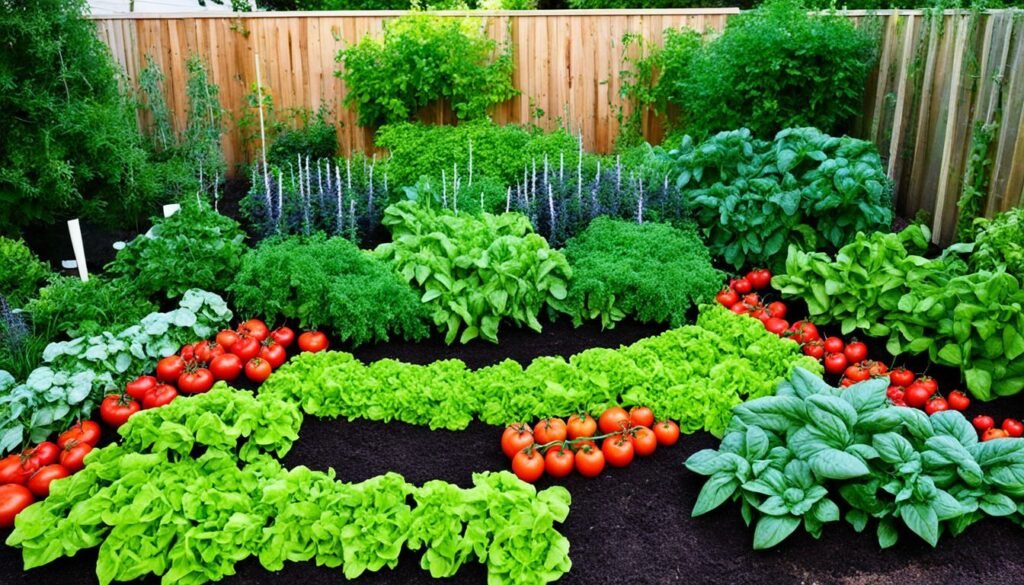
Below is a table illustrating common intercropping pairings that showcase the essential elements of a flourishing organic garden. Each pairing is chosen for its complementary natural pest control abilities, nutrient sharing, and evidenced benefits seen in bio-diverse gardening.
| Companion Plant Pair | Benefit | Pest/Disease Control | Nutrient Sharing/Usage |
|---|---|---|---|
| Tomatoes & Basil | Enhanced flavor | Repels flies and mosquitoes | Basil enhances the uptake of essential nutrients around tomatoes |
| Carrots & Chives | Improved root growth | Chives deter carrot flies | Chives break up compacted soil, aiding carrot root expansion |
| Cucumbers & Nasturtium | Healthy growth promotion | Nasturtium acts as a trap crop for aphids | Nasturtiums provide a ground cover, retaining moisture for cucumber roots |
| Corn & Beans | Structural support | Beans repel beetles and attract beneficial insects | Beans fix nitrogen, which benefits corn’s high nitrogen need |
| Spinach & Strawberries | Mutual protection | Spinach provides ground cover, repelling weeds that can affect strawberries. | Spinach can take up nutrients released too late in the season for strawberries |
What stands out in this organic companion planting guide is how it embodies the very essence of what it means to work in harmony with nature. By adopting these intercropping methods, not only are growers rewarded with a bountiful harvest, but they also contribute to the creation of a more sustainable, environmentally conscious form of agriculture.
Remember, in organic gardening, every plant has a role, a companion, and a contribution to the greater good of the garden.
Creating Your Companion Planting Chart
As you delve into the world of plant synergy in organic farming, understanding the intricate relationships between various plant species becomes paramount. The creation of a companion planting chart is an invaluable tool for deploying these insights in a practical, visual format. This guide serves as a clear reference point to maximize the benefits of your labor, fostering a sustainable eco-friendly garden environment.
Companion vs. Antagonist Plants: Who to Group Together
Identifying which plants complement each other and which should be kept apart is the essence of a functioning organic companion planting guide. For instance, tomatoes relish the company of lettuce and basil, forming a classic trio where each plant aids the others. Conversely, garlic’s strong growth deterrent effects on peas and beans exemplify the necessity of understanding antagonistic relationships. Charting these companionships ensures that each plant has the best conditions to thrive.
| Companion Plants | Benefits | Antagonist Plants | Negative Interactions |
|---|---|---|---|
| Beans and Marigolds | Pest deterrence and soil health | Beans and Chives | Growth inhibition |
| Carrots and Tomatoes | Root health and flavor improvement | Carrots and Dill | Competition for resources |
| Spinach and Strawberries | Ground cover and reduced weeds | Spinach and Potatoes | Risk of blight spread |
Organic Crop Rotation Strategies with Companion Planting
Integrating organic crop rotation strategies into your companion planting regime not only enhances nutrient uptake but also disrupts the lifecycle of common pests, minimizing crop susceptibility to diseases. Thoughtful planning about what follows what in your planting space can imbue your soil with the dynamism it requires for sustained organic bounty. By embracing these practices, your garden becomes a testament to the pinnacle of sustainable gardening practices.
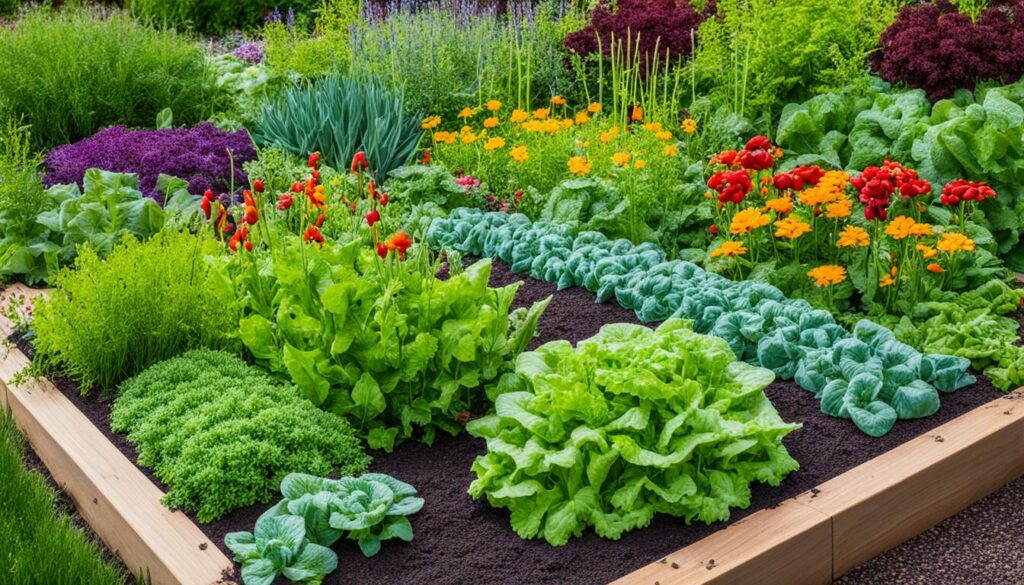
Relying on this coherent approach, gardeners and farmers can develop a deep appreciation for the interplay of various plants and their surroundings. Whether you’re a seasoned green thumb or a beginner in the gardening community, the investment in a companion planting chart will illuminate the path to a more vibrant and balanced garden. Witness as your informed choices echo through your garden’s ecosystem, culminating in an abundance of healthy, sustainable produce.
Conclusion
In the journey to foster a garden that flourishes while adhering to the ethics of sustainability, an organic companion planting guide becomes an invaluable resource. This venerable practice, enriched by generations of empirical wisdom and honed by contemporary ecological insights, affords a plethora of benefits that embody the very essence of a thriving agroecosystem. The advantages of companion planting are manifold, cutting across the spectrum from bolstering plant synergy to fortifying biodiversity, from instituting natural pest management solutions to amplifying crop yields.
The tapestry of a garden interwoven with companion plants is more than just a tableau of greenery; it represents a living mosaic where each species is meticulously placed to complement and enhance one another. By drawing from the wellspring of traditional knowledge and blending it with sustainable gardening best practices, gardeners are empowered to curate landscapes that are not only high-yielding but also intrinsically balanced and sustainable. The commitment to this approach signifies a step towards a more organic and self-sustaining style of horticulture, one that harmonizes with nature’s intrinsic patterns.
Embracing organic companion planting is, thus, a declaration of our commitment to sustainable growth and ecological stewardship. As gardens burgeon under these practices, they become vivid portrayals of environmental synergy and the endless potential that arises from planting with purpose and foresight. Gardeners who adopt this system will see their endeavors bloom to the fullest expression of nature’s generosity, fostering a legacy of abundance and ecological harmony for generations to come.



